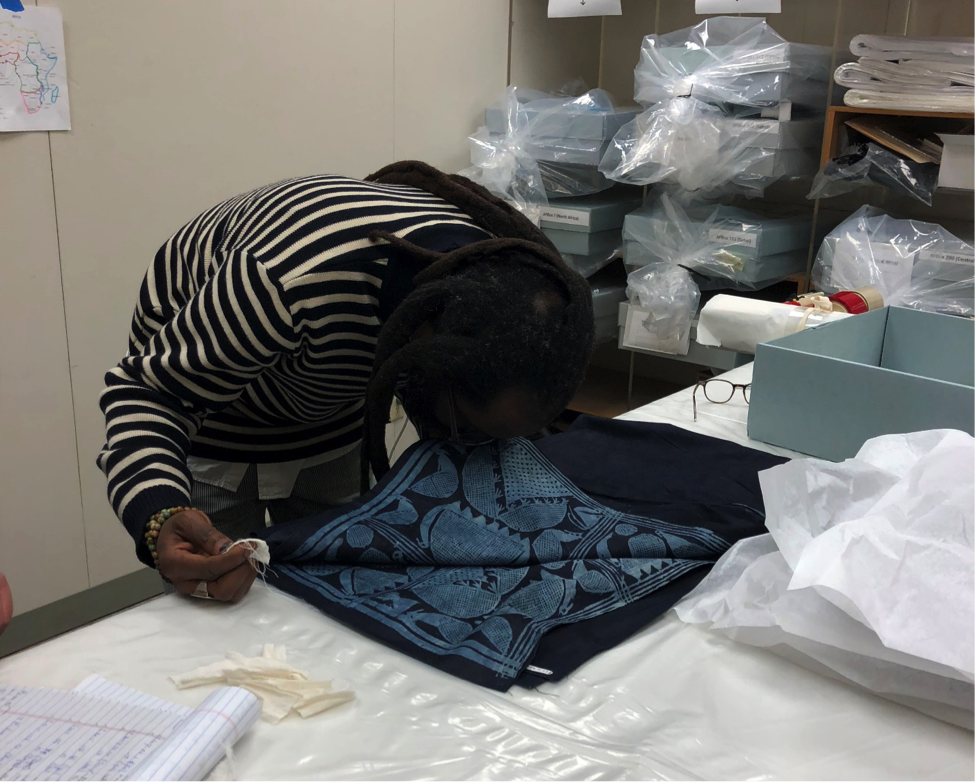By Nicole LaBouff, associate curator of textiles at Mia, and Jan-Lodewijk Grootaers, curator of African art at Mia and head of the Department of the Arts of Africa and the Americas
•••
This past May, Mia welcomed Malian artist Aboubakar Fofana. He was at the museum to discuss a potential exhibition in Mia’s Charleston period rooms, in 2020. But while he was here, he was shown the museum’s West African textile holdings, and he offered his expertise on how they were made.
Fofana first fell in love with calligraphy and was formally trained in the practice. But he is now an internationally recognized textile artist, working primarily in the medium of fermented indigo vat dyeing. His hand-spun, hand-woven, organic Malian cotton textiles—dyed with organic local indigo—reflect his interest in West Africa’s textile heritage and his commitment to environmental sustainability, in contrast to the industrial textiles that flooded Mali during and after European colonialism.

Indigo dye is created through fermentation—a process that produces a distinctive smell. Fofana’s assessment of Mia’s textiles included sniffing them.
Mia plans to reinstall the Charleston rooms with a focus on the use and cultivation of indigo, including Fofana’s work. The paneling of these rooms came from the 1772 estate of Colonel John Stuart, who was Britain’s superintendent of Indian affairs for its southern colonies, in the 1760s and ’70s, and a slave owner whose plantations produced both indigo and rice. Last year, the rooms were made over to focus on rice cultivation on both sides of the Atlantic, as well as Stuart’s relationship with the Cherokee Nation and the enslaved West Africans who worked his land. The next installation will focus on indigo, in both South Carolina and West Africa.
In Mali, Fofana and others are reviving the indigo industry, from growing the plants and processing them into dye to supporting local cotton textile weavers. He has traveled throughout West Africa to study the methods, materials, and products of artists who work within local textile traditions. His efforts in West Africa parallel similar movements around the world to reinvest in traditional, locally sourced dyes. Fofana is also interested in the cultivation of indigo in other parts of the world, researching how it fared under colonial rule, whether in India or the Americas.
As a result of his work, Fofana has an encyclopedic knowledge of indigo-dyed West African textiles. At Mia, Fofana kindly offered to examine about a dozen blue-colored textiles from West Africa, mainly Mali and Nigeria. They had been donated to the museum over the past twenty years, with little background information.
Fermented indigo dyeing is time-consuming, and since the late 1800s more and more weavers all over the world have been using fibers dyed with synthetic indigo. Unlike natural indigo, which forms molecular bonds with the textile, the chemical dye transfers more readily through washing and contact. Through observation and testing, Fofana was able to determine whether, and to what extent, synthetic indigo had been used and mixed with the natural dye. It turns out that more than half of the examined textiles had little or no natural indigo, a useful finding that will determine how West African textiles will be put on display in the future.
Top photo: Jan-Lodewijk Grootaers, Mia’s curator of African Art, and Nicole LaBouff, Mia’s curator of Textiles, examine a blue-dyed West African textile with artist Aboubakar Fofana.

